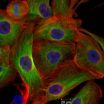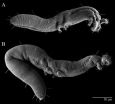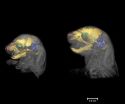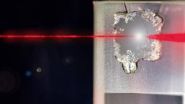(Press-News.org) Johns Hopkins researchers report that people with chronic insomnia show more plasticity and activity than good sleepers in the part of the brain that controls movement.
"Insomnia is not a nighttime disorder," says study leader Rachel E. Salas, M.D., an assistant professor of neurology at the Johns Hopkins University School of Medicine. "It's a 24-hour brain condition, like a light switch that is always on. Our research adds information about differences in the brain associated with it."
Salas and her team, reporting in the March issue of the journal Sleep, found that the motor cortex in those with chronic insomnia was more adaptable to change — more plastic — than in a group of good sleepers. They also found more "excitability" among neurons in the same region of the brain among those with chronic insomnia, adding evidence to the notion that insomniacs are in a constant state of heightened information processing that may interfere with sleep.
Researchers say they hope their study opens the door to better diagnosis and treatment of the most common and often intractable sleep disorder that affects an estimated 15 percent of the United States population.
To conduct the study, Salas and her colleagues from the Department of Psychiatry and Behavioral Sciences and the Department of Physical Medicine and Rehabilitation used transcranial magnetic stimulation (TMS), which painlessly and noninvasively delivers electromagnetic currents to precise locations in the brain and can temporarily and safely disrupt the function of the targeted area. TMS is approved by the U.S. Food and Drug Administration to treat some patients with depression by stimulating nerve cells in the region of the brain involved in mood control.
The study included 28 adult participants — 18 who suffered from insomnia for a year or more and 10 considered good sleepers with no reports of trouble sleeping. Each participant was outfitted with electrodes on their dominant thumb as well as an accelerometer to measure the speed and direction of the thumb.
The researchers then gave each subject 65 electrical pulses using TMS, stimulating areas of the motor cortex and watching for involuntary thumb movements linked to the stimulation. Subsequently, the researchers trained each participant for 30 minutes, teaching them to move their thumb in the opposite direction of the original involuntary movement. They then introduced the electrical pulses once again.
The idea was to measure the extent to which participants' brains could learn to move their thumbs involuntarily in the newly trained direction. The more the thumb was able to move in the new direction, the more likely their motor cortexes could be identified as more plastic.
Because lack of sleep at night has been linked to decreased memory and concentration during the day, Salas and her colleagues suspected that the brains of good sleepers could be more easily retrained. The results, however, were the opposite. The researchers found much more plasticity in the brains of those with chronic insomnia.
Salas says the origins of increased plasticity in insomniacs are unclear, and it is not known whether the increase is the cause of insomnia. It is also unknown whether this increased plasticity is beneficial, the source of the problem or part of a compensatory mechanism to address the consequences of sleep deprivation associated with chronic insomnia. Patients with chronic phantom pain after limb amputation and with dystonia, a neurological movement disorder in which sustained muscle contractions cause twisting and repetitive movements, also have increased brain plasticity in the motor cortex, but to detrimental effect.
Salas says it is possible that the dysregulation of arousal described in chronic insomnia — increased metabolism, increased cortisol levels, constant worrying — might be linked to increased plasticity in some way. Diagnosing insomnia is solely based on what the patient reports to the provider; there is no objective test. Neither is there a single treatment that works for all people with insomnia. Treatment can be a hit or miss in many patients, Salas says.
She says this study shows that TMS may be able to play a role in diagnosing insomnia, and more importantly, she says, potentially prove to be a treatment for insomnia, perhaps through reducing excitability.
INFORMATION:
The study was supported by the National Institutes of Health's National Institute of Child Health and Human Development (R01 HD053793) and the National Institute of Arthritis and Musculoskeletal and Skin Diseases (R01AR054871 and R01AR059410).
Other Johns Hopkins researchers involved in the research include Joseph M. Galea, Ph.D.; Alyssa A. Gamaldo, Ph.D.; Charlene E. Gamaldo, M.D.; Richard P. Allen, Ph.D.; Michael T. Smith, Ph.D.; Gabriela Cantarero, Ph.D.; Barbara D. Lam; and Pablo A. Celnik, M.D.
For more information:
http://www.hopkinsmedicine.org/profiles/results/directory/profile/0021181/rachel-salas
Johns Hopkins Medicine (JHM), headquartered in Baltimore, Maryland, is a $6.7 billion integrated global health enterprise and one of the leading health care systems in the United States. JHM unites physicians and scientists of the Johns Hopkins University School of Medicine with the organizations, health professionals and facilities of The Johns Hopkins Hospital and Health System. JHM's vision, "Together, we will deliver the promise of medicine," is supported by its mission to improve the health of the community and the world by setting the standard of excellence in medical education, research and clinical care. Diverse and inclusive, JHM educates medical students, scientists, health care professionals and the public; conducts biomedical research; and provides patient-centered medicine to prevent, diagnose and treat human illness. JHM operates six academic and community hospitals, four suburban health care and surgery centers, and more than 30 primary health care outpatient sites. The Johns Hopkins Hospital, opened in 1889, was ranked number one in the nation for 21 years in a row by U.S. News & World Report.
Johns Hopkins Medicine
Media Relations and Public Affairs
Media Contacts:
Stephanie Desmon
410-955-8665; sdesmon1@jhmi.edu
Lauren Nelson; 410-955-8725; lnelso35@jhmi.edu END
Researchers identify brain differences linked to insomnia
Increased brain plasticity in motor cortex distinguishes poor sleepers from good ones
2014-02-28
ELSE PRESS RELEASES FROM THIS DATE:
UCLA study finds robotic-assisted prostate surgery offers better cancer control
2014-02-28
An observational study from UCLA's Jonsson Comprehensive Cancer Center has found that prostate cancer patients who undergo robotic-assisted prostate surgery have fewer instances of cancer cells at the edge of their surgical specimen and less need for additional cancer treatments like hormone or radiation therapy than patients who have traditional "open" surgery.
The study, published online Feb. 19 in the journal European Urology, was led by Dr. Jim Hu, UCLA's Henry E. Singleton Professor of Urology and director of robotic and minimally invasive surgery in the urology ...
Let there be tissue-penetrating light: Scientists develop new nanoscale method to fight cancer
2014-02-28
Researchers from UCLA's Jonsson Comprehensive Cancer Center have developed an innovative cancer-fighting technique in which custom-designed nanoparticles carry chemotherapy drugs directly to tumor cells and release their cargo when triggered by a two-photon laser in the infrared red wavelength.
The research findings by UCLA's Jeffrey Zink, a professor of chemistry and biochemistry, and Fuyu Tamanoi, a professor of microbiology, immunology and molecular genetics, and their colleagues were published online Feb. 20 in the journal Small and will appear in a later print ...
Robert Avery, D.O., M.S.C.E., studies innovations to improve vision in children with tumors
2014-02-28
Robert Avery, DO, MSCE, of Children's National Health System and colleagues are establishing innovative approaches with technology and medication to improve the vision of young children who have visual pathway glioma, a type of brain tumor.
Most optic pathway gliomas cause vision loss in children between one and eight years of age. As many as 20 percent of children with neurofibromatosis type 1 -- a genetic disorder that occurs in 1 in every 4,000 births – may develop these tumors. It is estimated that nearly half of those children may experience vision problems from ...
Tackling tumors with space station research
2014-02-28
In space, things don't always behave the way we expect them to. In the case of cancer, researchers have found that this is a good thing: some tumors seem to be much less aggressive in the microgravity environment of space compared to their behavior on Earth. This observation, reported in research published in February by the FASEB Journal, could help scientists understand the mechanism involved and develop drugs targeting tumors that don't respond to current treatments. This work is the latest in a large body of evidence on how space exploration benefits those of us on ...
Worm-like mite species discovered on Ohio State's campus
2014-02-28
COLUMBUS, Ohio – It looks like a worm and moves like a worm – sort of. But it is a previously unidentified microscopic species of mite that was discovered by a graduate student on The Ohio State University campus.
Affectionately dubbed the "Buckeye Dragon Mite" by Ohio State's Acarology Laboratory, the mite is officially named Osperalycus tenerphagus, Latin for "mouth purse" and "tender feeding," in a nod to its complex and highly unusual oral structure.
This mite doesn't resemble a mythological winged dragon, but the snake-like Chinese dancing dragons that appear in ...
3-D imaging sheds light on Apert syndrome development
2014-02-28
Three dimensional imaging of two different mouse models of Apert Syndrome shows that cranial deformation begins before birth and continues, worsening with time, according to a team of researchers who studied mice to better understand and treat the disorder in humans.
Apert Syndrome is caused by mutations in FGFR2 -- fibroblast growth factor receptor 2 -- a gene, which usually produces a protein that functions in cell division, regulation of cell growth and maturation, formation of blood vessels, wound healing, and embryonic development. With certain mutations, this gene ...
GOES-West satellite eyes soggy storm approaching California
2014-02-28
A swirling Eastern Pacific Ocean storm system headed for California was spotted by NOAA's GOES-West satellite on February 28. According to the National Weather Service, this storm system has the potential to bring heavy rainfall to the drought-stricken state.
The storm was captured using visible data from NOAA's GOES-West or GOES-15 satellite on Feb. 28 at 1430 UTC/6:30 a.m. PST was made into an image by NASA/NOAA's GOES Project at NASA's Goddard Space Flight Center in Greenbelt, Md. The storm's center appeared as a tight swirl, with bands of clouds and showers already ...
NASA satellite sees great freeze over Great Lakes
2014-02-28
At night, as cold settles in, lake ice creaks and groans. It's been excessively cold, and I camped exposed on the snow-swept surface. Other than the lack of vegetation and the sounds at night, you'd never know you were on a lake. It feels like an empty plain. In some places, you see pressure ridges where ice has pushed into itself, sticking up like clear blue stegosaurus plates. -- Craig Childs
Author Craig Childs is not describing an Arctic lake. He's describing the bitterly cold and frozen scene on Lake Superior, during his February 2014 trek on the ice near the coast ...
Ultra-fast laser spectroscopy lights way to understanding new materials
2014-02-28
Scientists at the U.S. Department of Energy's Ames Laboratory are revealing the mysteries of new materials using ultra-fast laser spectroscopy, similar to high-speed photography where many quick images reveal subtle movements and changes inside the materials. Seeing these dynamics is one emerging strategy to better understanding how new materials work, so that we can use them to enable new energy technologies.
Physicist Jigang Wang and his colleagues recently used ultra-fast laser spectroscopy to examine and explain the mysterious electronic properties of iron-based superconductors. ...
Detection of water vapor in the atmosphere of a hot jupiter
2014-02-28
Although liquid water covers a majority of Earth's surface, scientists are still searching for planets outside of our solar system that contain water. Researchers at Caltech and several other institutions have used a new technique to analyze the gaseous atmospheres of such extrasolar planets and have made the first detection of water in the atmosphere of the Jupiter-mass planet orbiting the nearby star tau Boötis. With further development and more sensitive instruments, this technique could help researchers learn about how many planets with water—like Earth—exist within ...
LAST 30 PRESS RELEASES:
There are new antivirals being tested for herpesviruses. Scientists now know how they work
CDI scientist, colleagues author review of global burden of fungus Candida auris
How does stroke influence speech comprehension?
B cells transiently unlock their plasticity, risking lymphoma development
Advanced AI dodel predicts spoken language outcomes in deaf children after cochlear implants
Multimodal imaging-based cerebral blood flow prediction model development in simulated microgravity
Accelerated streaming subgraph matching framework is faster, more robust, and scalable
Gestational diabetes rose every year in the US since 2016
OHSU researchers find breast cancer drug boosts leukemia treatment
Fear and medical misinformation regarding risk of progression or recurrence among patients with breast cancer
Glucagonlike peptide-1 receptor agonists and asthma risk in adolescents with obesity
Reviving dormant immunity: Millimeter waves reprogram the immunosuppressive microenvironment to potentiate immunotherapy without obvious side effects
Safety decision-making for autonomous vehicles integrating passenger physiological states by fNIRS
Fires could emit more air pollution than previously estimated
A new way to map how cells choose their fate
Numbers in our sights affect how we perceive space
SIMJ announces global collaborative book project in commemoration of its 75th anniversary
Air pollution exposure and birth weight
Obstructive sleep apnea risk and mental health conditions among older adults
How talking slows eye movements behind the wheel
The Ceramic Society of Japan’s Oxoate Ceramics Research Association launches new international book project
Heart-brain connection: international study reveals the role of the vagus nerve in keeping the heart young
Researchers identify Rb1 as a predictive biomarker for a new therapeutic strategy in some breast cancers
Survey reveals ethical gaps slowing AI adoption in pediatric surgery
Stimulant ADHD medications work differently than thought
AI overestimates how smart people are, according to HSE economists
HSE researchers create genome-wide map of quadruplexes
Scientists boost cell "powerhouses" to burn more calories
Automatic label checking: The missing step in making reliable medical AI
Low daily alcohol intake linked to 50% heightened mouth cancer risk in India
[Press-News.org] Researchers identify brain differences linked to insomniaIncreased brain plasticity in motor cortex distinguishes poor sleepers from good ones





